Operation of the homeless persons legislation in Scotland: quarters ending 30 June and 30 September 2011 (including households in temporary accommodation at 31 December 2011)
Statistics relating to the operation of the homeless persons legislation in Scotland: quarters ending 30 June and 30 September 2011, also including households in temporary accommodation as at 31 December 2011.
Assessments
Assessments
A total of 24,281 assessments were made during April to September 2011. This is a reduction of around 6,000 cases and mirrors the fall in applications. Of these 24,281 assessments, 18,455 (76%) were assessed as homeless or potentially homeless - the same proportion as in April to September 2010.
While the number of assessments has fallen the general pattern of assessments in the most recent period has remained broadly the same as a year earlier. Just over three quarters (76%) of applications were assessed as homeless or potentially homeless. In 4% of cases homelessness was resolved before assessment, contact was lost with 7% and 7% were assessed as not homeless.
Chart 6:
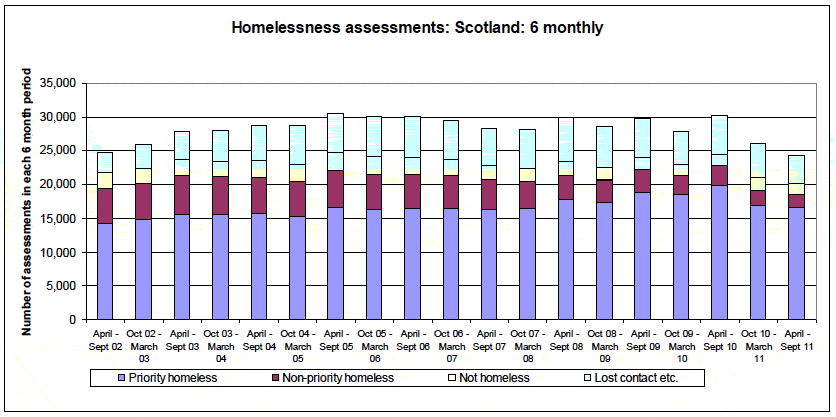
Homeless assessments distinguish between those in priority need and non-priority homeless. Local authorities have a duty to provide settled accommodation for unintentionally homeless households in priority need. Scottish homelessness legislation, reflected in a Scottish Government performance target, has the objective that by 31st December 2012 all homeless households will be entitled to settled accommodation. Councils are moving to this target by assessing increasing proportions of homeless households as priority homeless. The commitment will be met when 100% of those assessed as homeless are also accorded priority.
For Scotland as a whole, between April and September 2011, 90% of applicants assessed as homeless were accorded priority, an increase of three percentage points over the same period in 2010. and an increase of 17 percentage points over the same period in 2002 (Chart 7). While the percentage of priority homeless has increased the number of priority homeless fell from a peak of just under 20,000 in the period April - September 2010 to around 17,000 in each of Oct - March 2011 and April - September 2011. This is a consequence of the marked fall in applications and assessments in the period.
At the local authority level, between July and September 2011:
- in nine council areas 100% of homeless assessments were assessed as having a priority need. These councils were Angus, Dundee City, Moray, North Ayrshire, Orkney, Renfrewshire, Scottish Borders, Stirling and West Dunbartonshire. This is an increase of six councils compared with the same quarter in 2010;
- in another 11 council areas - East Renfrewshire, Inverclyde, Glasgow City, Dumfries & Galloway, Falkirk, Clackmannanshire, Perth & Kinross, South Ayrshire, South Lanarkshire, Shetland, Midlothian and Argyll & Bute - more than 90% of homeless were assessed as having a priority need;
- eight council areas assessed between 80% and 90% of homeless cases as having a priority need;
- three council areas - Highland (79%), North Lanarkshire(78%) and Eilean Siar (74%) assessed between 70% and 80% of homeless cases as having a priority need;
- East Lothian Council assessed 66% of homeless cases as having a priority need.
Chart 7:
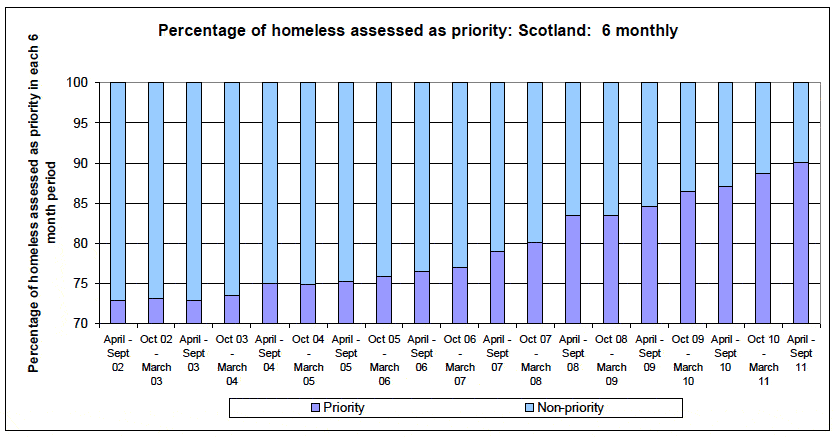
Chart 8:
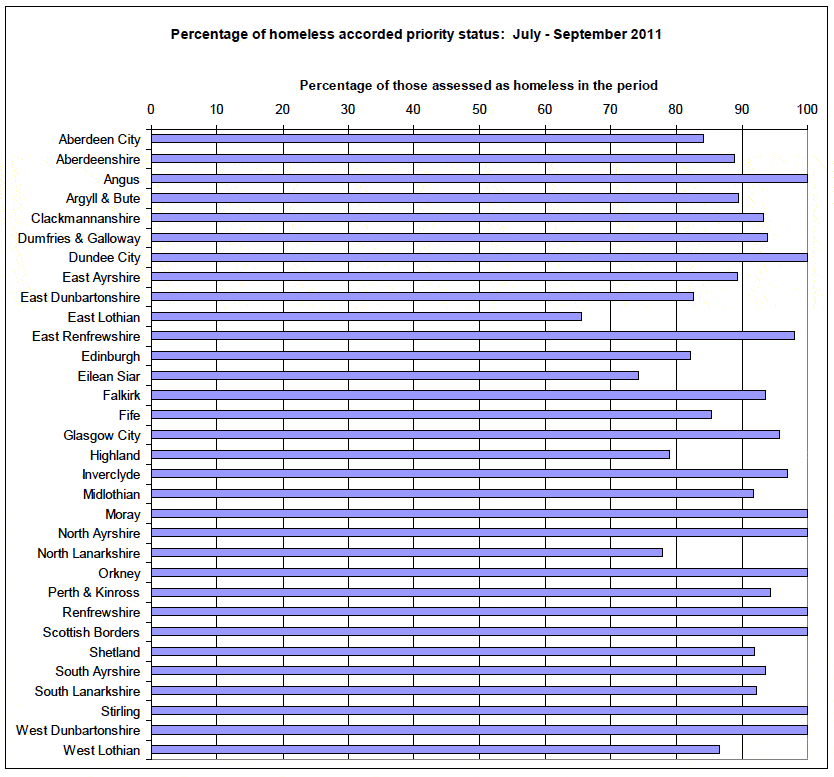
The percentage of homelessness assessments identified as repeat cases (i.e. where a previous application from the household had been closed less than 12 months before the current assessment) has fallen from just under 10% in the six monthly periods in 2002-03 to 5.9% between April and September 2011. (Chart 9).
The rate of repeat homelessness varies by local authority area and stands at over 10% in Inverclyde, Moray, North Ayrshire and Stirling (Chart 10). However, these local authorities have high rates of repeat homelessness - not because the number of repeating cases has increased markedly - but rather because the number of homelessness assessments overall has reduced sharply. For example, in North Ayrshire there were 36 repeat cases in the period April to September 2011, out of 348 homeless cases. The repeat rate is therefore 36/348 = 10.3%. However, one year ago there were 33 repeats but 371 homeless cases, a repeat rate of 8.9%. Whilst the actual number of repeat cases has increased by only three cases, the repeat rate has increased by over a percentage point.
Chart 9:
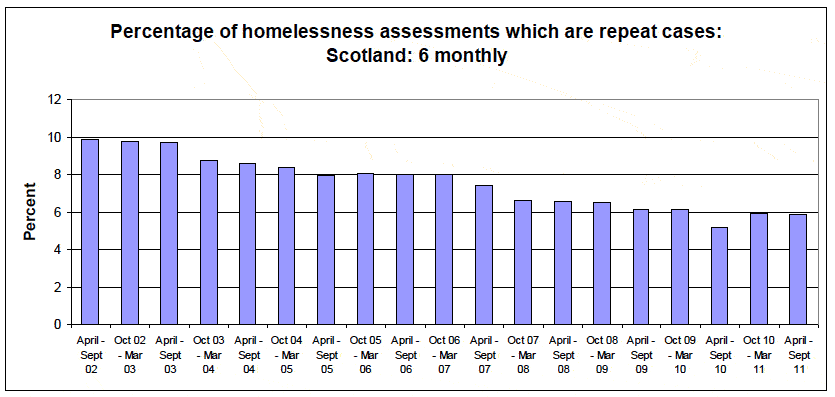
Chart 10:
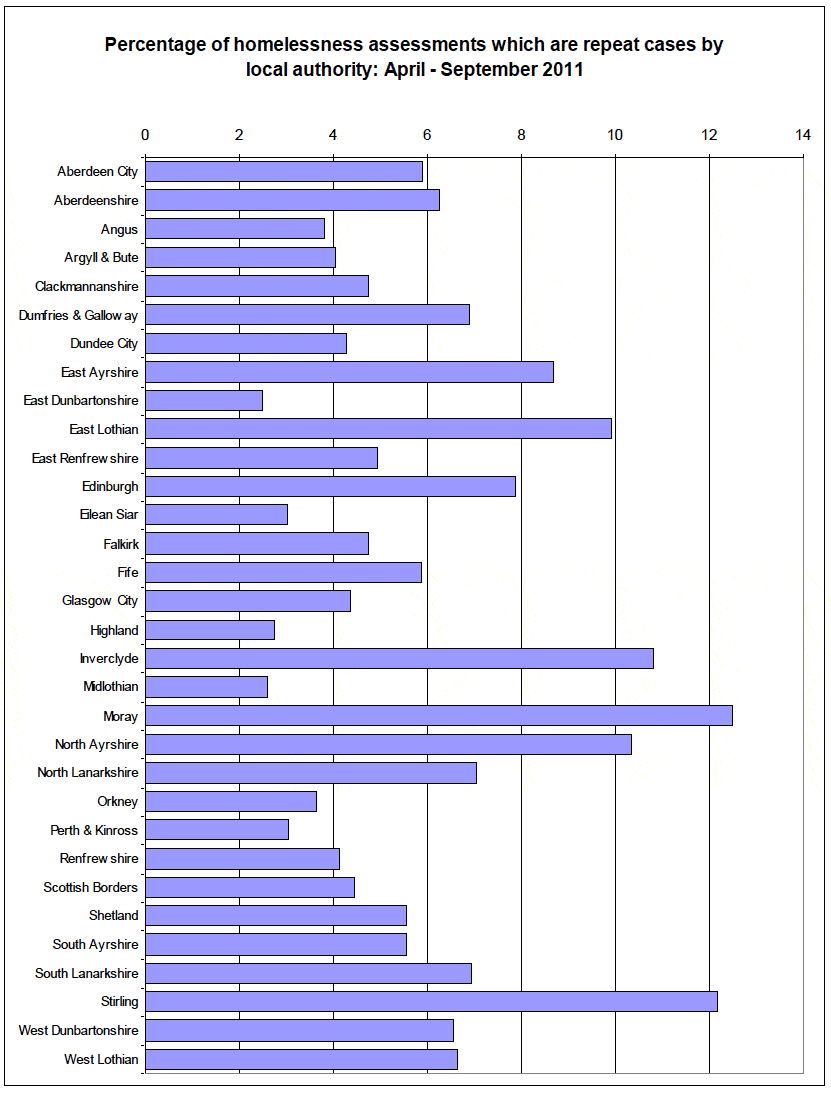
Contact
Email: Andrew Waugh
There is a problem
Thanks for your feedback